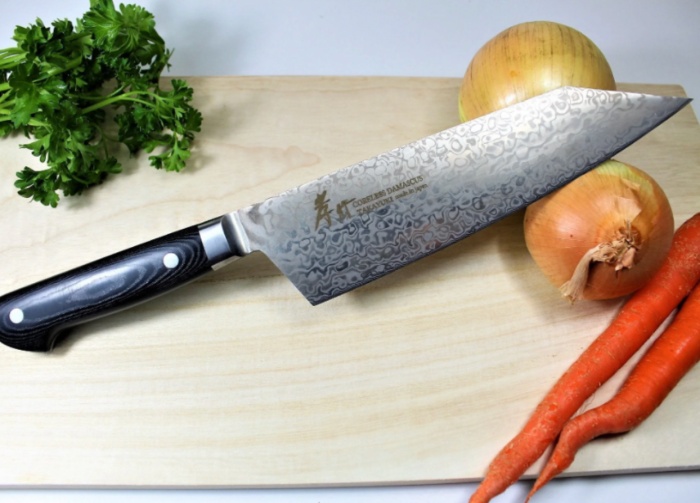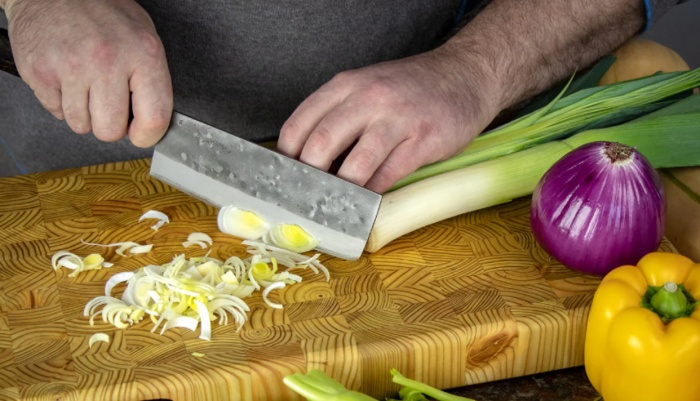Like any other craft, cooking relies on both skill and a specific set of tools to fully capture the flavours and ingredients in their most complete form. Japanese chefs have been renowned for making the finest and most precise precision knives available on the market for centuries, thanks to their expert craftsmanship and traditional techniques.
Given the rich and long history behind Japanese knives, it’s no surprise that there’s a lot of variety in terms of design and function. Given their versatile and well-crafted blades, they’ve become an integral part of running a traditional kitchen. They’re just as important as choosing the best restaurant apron or other kitchen accessories in navigating the culinary world.
The History and Craftsmanship of Japanese Knives
The initial development of these sturdy and unwavering professional chef tools dates back to the early Heian period in the 8th century. Their origins are closely tied to traditional Japanese swords, with the first kitchen knives being made by repurposing these blades. They were originally made with carbon steel, which gave them the sharpness and durability that chefs need to comfortably handle all types of food preparation.
Over time, traditional knife-making techniques evolved and the materials used were modified to better suit modern cooking needs. High-carbon steels were the predominant material for a long time, but soon stainless steel and other alloys were also used. By the 18th century, Japanese knives had become some of the most renowned and sought-after blades in the world.
The sheer amount of skill and attention to detail that goes into the development of each knife set is nothing short of impressive. The forging process involves hammering specific layers of steel and other alloys together, which is then heated up to just the right temperature so that it becomes malleable enough for the blades to be ground and honed. Once the blade is sharpened, it’s then polished and treated with a special oil to protect it from corrosion.
What Are the Different Types of Japanese Knives?
Given their widespread popularity and almost universal appeal, these professional chef tools come in many shapes and sizes. They all have their own unique uses, with some being better for specific tasks in the kitchen whereas others are more suitable for general food preparation.
Gyuto (Japanese Chef’s Knife)
Starting off with the most common and widely used type of Japanese knife, the Gyuto is a chef’s knife designed for all-purpose use. This double-bevelled blade is often the go-to choice for chefs, but can also be used in both home and commercial kitchens. It features a pointed tip and curved profile, with specialised versions (such as the Sujihiki) being made for slicing meat and fish.
Its thin yet long and wide design come in handy for cutting up large vegetables, grinding herbs and spices, as well as butchering larger cuts of meat. It doesn’t weigh down the handle nor does it feel too heavy to wield – instead, it offers a balanced and comfortable grip in the user’s hand.

Santoku (All-Purpose Knife)
A slightly more pointed variant of the Gyuto, the Santoku is a versatile and all-purpose knife specifically designed for quick and easy chopping. Its shorter and thinner blade makes it easier to control and manoeuvre around food items, while the hollow-ground indentations along its length help to reduce friction and make slicing faster and smoother.
Moreover, the Santoku offers a more comfortable grip than traditional chef knives due to its shorter and lighter handle. It feels like an extension of the user’s arm, which is great for both professional chefs and home cooks who want to move around quickly in the kitchen. You won’t come across too many tasks that this knife can’t handle, thanks to its versatile and well-rounded design.
Nakiri (Vegetable Knife)
The Nakiri is a uniquely designed vegetable knife, with a rectangular blade and distinctive double-ground edge that’s perfect for slicing through hard vegetables such as carrots, potatoes, and turnips. Its shallow profile allows it to keep a constant angle with the cutting board, while its thin and wide blade makes it much easier to mince and chop herbs and spices.
It doesn’t take much effort to master the art of using a Nakiri, as long as you pay attention to your cutting technique. You place the blade flat against the cutting board and use a back-and-forth sawing motion to slice through softer vegetables. As for harder ones, you can press down firmly and rock the blade to produce thin slices.

Yanagiba (Sushi Knife)
No Japanese kitchen is complete without the Yanagiba, a thin and exceptionally sharp knife that’s custom-made for preparing sushi. It has an elongated and narrow blade that’s ideal for slicing through fish and other seafood with minimal effort. In fact, the Yanagiba is often used by professional sushi chefs, since its combination of sharpness and precision brings out the full flavour and texture of the ingredients.
Because it’s so sharp, it requires a bit more care than other knife types. Its elegant and thin profile is inherently more delicate and therefore can’t handle any sort of rough chopping or slicing. Plus, if it’s not stored properly and maintained regularly, the blade will easily lose its edge and become dull.
Deba (Heavy-Duty Butchery Knife)
The last type of Japanese is the Deba, which was originally used for chopping and filleting fish. Its robust and thick blade is designed to resist wear and tear, with its curved profile allowing for deep cuts through tough meat. The thicker spine brings a bit more leverage when cutting through bones and other tough parts of the fish.
Taking into account the specific tasks it’s designed for, the Deba is arguably one of the heaviest and most durable knives in its class. Its heftiness has a more substantial feel to it, which is excellent for butchers and fishermen who need a reliable tool that won’t break or lose its edge.

Care and Maintenance of Japanese Knives
In order to prolong the life of your Japanese knife set, proper care must be taken when cleaning and storing it. Always use a soft cloth to wipe the blade and handle free from food residue, as any abrasive material can easily damage its delicate surface. Avoid cleaning the knife in a dishwasher, as it will only dull its edge and ruin its protective coating.
As for the sharpening part, you can either buy a whetstone to hone the blade or use an electric sharpener. Both can get the job done without any hassle, just make sure to use the right level of coarseness so that you don’t accidentally damage the blade in the process. You could send it to a professional sharpener if you’re not quite comfortable doing it yourself but make sure to keep the original box for its safe return.



